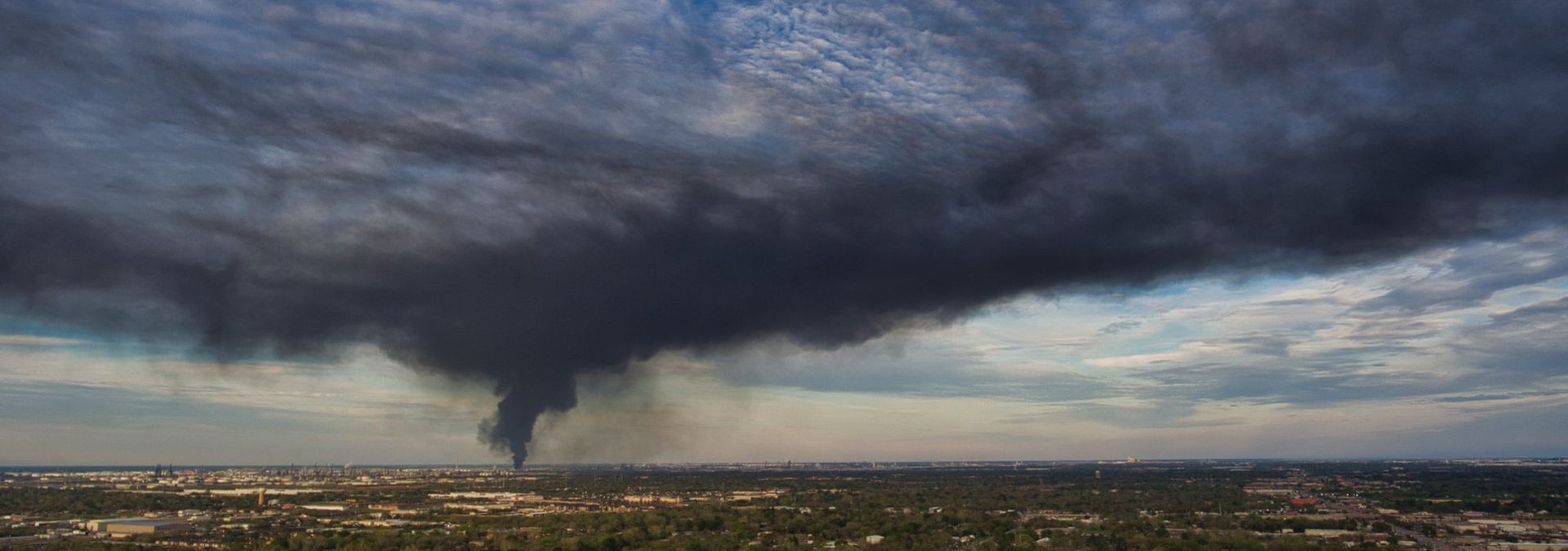
Houston must learn from our year of disasters
The Houston region has gone through at least six major chemical disasters in the past year.
Fred Vernon’s 4-month-old daughter was sleeping. It was the day before Thanksgiving. His wife and mother were in the kitchen. He stopped at the bank with his father when he said they heard a “big boom.”
The night before, the first explosion at the TPC Group plant in Port Neches near their home had created a “gray haze.” Now, he saw it turn into “a dark disgusting something that’s just spewing into the air.”
He knew they had to evacuate. He and his father rushed back. “I got out of the car,” Vernon said, “and it just hit you in the face.”
Nauseated, he put his hand against the house and started to throw up. He told his wife, “We’ve got to go now.” As they scrambled to load the car, Vernon wrapped his daughter in a blanket and covered her mouth. But, with the front door open, she was exposed to the air and started throwing up, too.
“It’s an image you don’t forget,” he said. “It does something to you.”
Usually, the images we embrace as a community are ones of bravery. It’s a first responder carrying a child through floodwaters, a man in a raincoat rescuing a family pet. The inspiration is important. But outrage is, too. What parent wouldn’t demand change once he’d gone through what Vernon has? What parent wouldn’t do whatever she could to prevent her family from going through that?
It’s been a bad year. We’ve gone through at least six major chemical disasters in our region. Last March, thousands of gallons of naphtha, a liquid that is used to make gasoline, started leaking at Intercontinental Terminals Company in Deer Park. Most of us had never heard of ITC. Then, all that naphtha ignited.
The U.S. Chemical Safety Board would find later that the tank farm lacked an emergency remote shutoff valve and alarms that would have alerted workers. The fires burned for four days, shutting down the Ship Channel, filling the air with dangerous levels of cancer-causing benzene, forcing communities to shelter in place.
Our skies — and our newsfeeds — were dominated by the plume from those fires. I remember waiting for the bus on Kirby Drive, some 20 miles away, and seeing it hanging over Rice Village. That’s an image you don’t forget, either.
Marco Garcia, who studies and works at the University of Houston, saw the plume rising as he walked to a Starbucks in South Pasadena. Months before, he’d joined the Sunrise Movement and met with Rep. Sylvia Garcia to ask her to support the Green New Deal and decarbonize the economy.
“To have nothing change and have a chemical fire erupt in my community,” he said, “was infuriating.”
It was only the beginning. Just 16 days later, in April, an explosion at KMCO in Crosby injured 30 workers and killed one. KMCO, like ITC, had dozens of workplace safety and environmental violations going back years. In July, the ExxonMobil Olefins plant in Baytown blew up and injured 37 workers. (It also blew up one day before ITC.)
The series of explosions at TPC followed in late November. After the first explosion, John Beard, Jr., who lives with his wife and daughter in Port Arthur, said, “One of the lights in our house was swinging, and we’re a good seven to eight miles away.”
Then, in January, the explosion at Watson Grinding and Manufacturing in Houston killed three more people and damaged 450 buildings.
Why does this keep happening? What do we have to do to keep it from happening again? As I’ve started working this year alongside community advocates and organizers, toxicologists, epidemiologists and environmental lawyers, I’ve learned that these disasters are preventable. It comes down to effective enforcement. The state is going to have to cooperate with the city and county. As a first step, leaders must commit to reducing air pollution from unauthorized releases by 50 percent in five years.
But neither industry nor the Texas Commission on Environmental Quality seems up to the task. The Environmental Integrity Project found that TCEQ’s budget for pollution control has been decimated by 35 percent since 2008, as industry has expanded dramatically. Beard, Jr., was a petrochemical worker for decades. His plant “gave employees all the tools they need to be safe,” but he saw larger issues with maintenance deferred until it was forgotten and legal loopholes that allowed plants to postpone other needed repairs. “The bottom line was dollars and cents.”
“My family, we’re not strangers to industry,” Vernon said. “It put me through college. But it becomes a problem when it’s irresponsible.”
That irresponsibility has been plain this year. The disasters have had impacts we are just beginning to understand.
“I still don’t know to what degree my daughter’s affected, or we’re affected,” Vernon said.
Dr. Brett Perkison, a physician with a practice in the Clear Lake and Pasadena area, cautions that it’s difficult to attribute the development of cancer and most other chronic diseases to the short-term releases that happen during chemical disasters like ITC. But, he said, the air pollutants that are released then can exacerbate an existing pulmonary disease, like asthma. And, at high enough levels, the pollutants can cause a type of lung disease called irritant asthma. Even six months after the ITC fires had been extinguished, he said, one patient was still reporting “breathing difficulty that began when he inhaled smoke that was released by the ITC fires.” And he was in his own home.
“We are still an oil and gas community, and we live with the burden that entails,” Garcia said. “Every day, I wake up with the recognition that another ITC fire could happen.”
Why should we live with that? Why should we live with an industry that waddles out a friendly mascot teaching children how to shelter in place instead of preventing the disasters from happening? Why should we live with a state environmental agency taking recommendations about the safety of cancer-causing chemicals from the largest producer of those chemicals? We shouldn’t. We should be outraged.
Just as the devastation of Hurricane Harvey led to a before and an after for our region, I want to believe that our year of disasters will, too. We have seen images that we shouldn’t see. After Harvey, we decided that we couldn’t go through it again. We wouldn’t. And it has led to stronger policies and a much more sober understanding of the risks we face. It has changed our region physically and emotionally.
There’s no reason why we shouldn’t change after this year of disasters. There’s no reason why these images should be any less forgettable.
Suzanne Williamson lives in Groves, Texas.
I moved here from Cypress in October of 2015. My husband took a job in Beaumont, and he actually works in the petrochemical industry, manufacturing heat exchangers. I knew the refineries were here. I didn’t understand the level of emissions and toxins and dangers. I was naive.
My son goes to Port Neches-Groves High School. If you’re in the football stadium on a Friday night, you can see TPC. It’s that close. You could walk to the plant. When the explosion happened, my son had gotten home about 10 minutes before, driving literally in front of TPC, because he was at a friend’s house.
I had just gone to bed. There was an initial shockwave, but then it felt like a car had run into my house going 100 miles an hour. It was that forceful. So, of course, you wake up and go, “What the hell was that?” The whole sky is lit up. All the neighbors are outside. We knew what happened, because it was all over Snapchat and Facebook, my son’s social media. The ceilings had fallen in. People in Port Neches’ windows were blown in. My house has damage, but nothing like some of the people’s much closer to the location.
During the voluntary evacuation, my whole family felt ill, with stomachaches, headaches, nausea, diarrhea. I had the [volatile organic compounds] inside of my house tested, and it was 0.6 parts per million. At 0.5 parts per million, you would be required to wear a respirator inside of a refinery.
My main concern now is that my son is at high school every day, and TPC has had several leaks since this happened. In January, he was texting me: “Mom, I think there’s a leak. The kids who were practicing softball outside have been told to come into the fieldhouse.”
I’m concerned because these are very toxic chemicals. Benzene, styrene, butadiene. These are known carcinogens. My son has played on the football team the past four years. Every day, they’re outside practicing right down the street from TPC.
A lot of people say, “Well, you knew the dangers when you moved here.” I was naive to think that companies are following the laws and that TCEQ and EPA are making them do it. I’ve learned.
Once you know better, you do better. Now I have the information to make informed decisions. And the informed decision is lawmakers are going to have to change our laws in Texas. The laws need to be changed to protect the people.
A lot of people have told me they are considering moving. I know people who have endured major health problems but they are afraid to talk about it or are in lawsuits. Oh, it’s horrible. It just gives me chills. This is unacceptable.
This is not normal.
We are considering moving. We just don’t think living in Jefferson County is a good idea for what we think is healthy and safe.
This article originally appeared in the Houston Chronicle.
West is a writer with Environmental Defense Fund. You can follow him on Twitter @allynwest.
STAY UP TO DATE
The quality of our newsletter is considered satisfactory and poses little or no risk.
SUBSCRIBE

